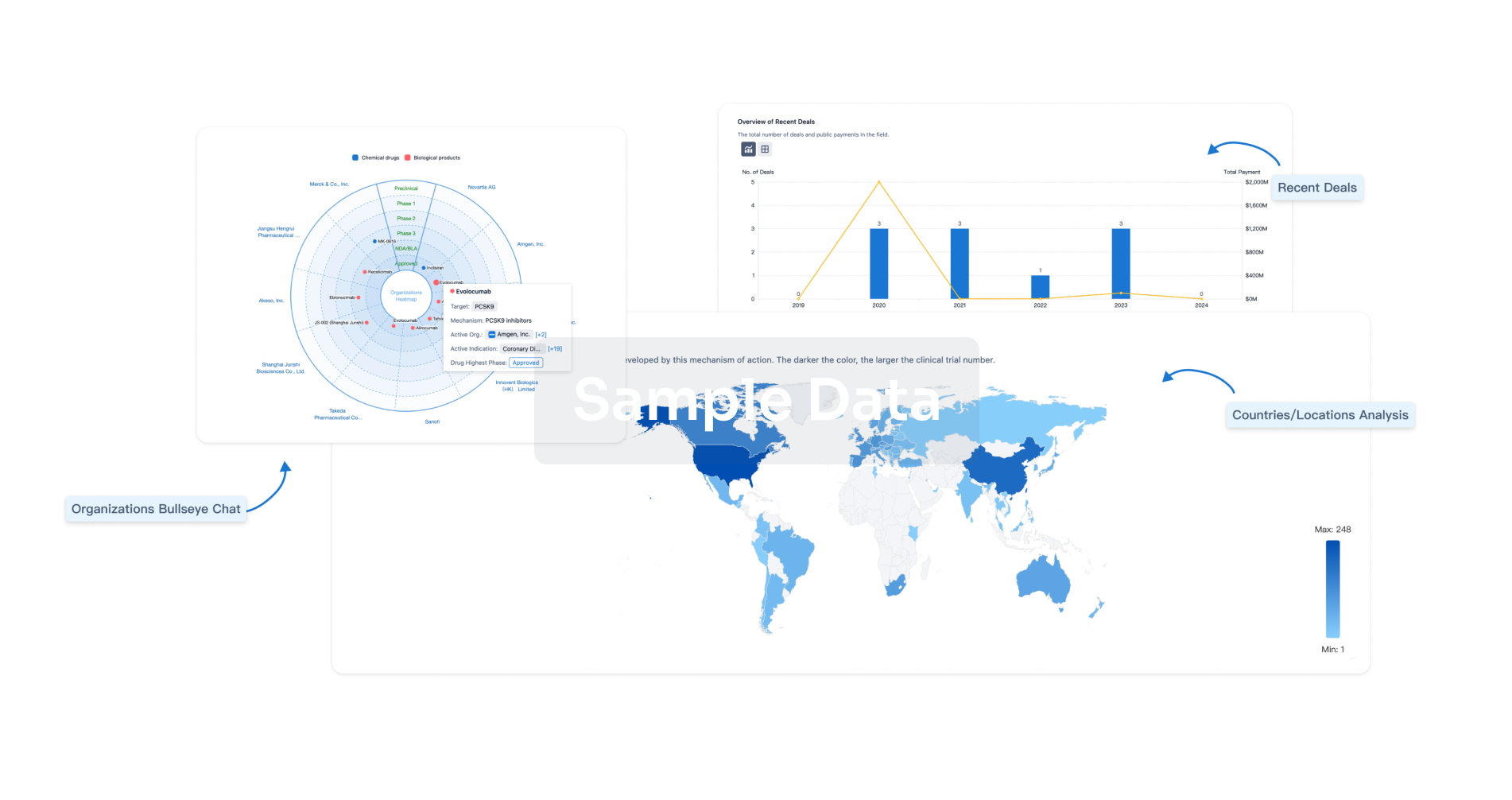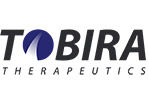Request Demo
Last update 08 May 2025
CCR5 x CCR2
Last update 08 May 2025
Related
10
Drugs associated with CCR5 x CCR2Target |
Mechanism CCR2 antagonists [+1] |
Active Org. |
Originator Org. |
Inactive Indication |
Drug Highest PhasePhase 3 |
First Approval Ctry. / Loc.- |
First Approval Date20 Jan 1800 |
Target |
Mechanism CCR2 antagonists [+2] |
Active Org. |
Originator Org. |
Active Indication |
Drug Highest PhasePhase 2 |
First Approval Ctry. / Loc.- |
First Approval Date20 Jan 1800 |
Target |
Mechanism CCR2 antagonists [+1] |
Active Org. |
Originator Org. |
Active Indication |
Inactive Indication |
Drug Highest PhasePhase 2 |
First Approval Ctry. / Loc.- |
First Approval Date20 Jan 1800 |
50
Clinical Trials associated with CCR5 x CCR2NCT05630885
A Limited-Center, Prospective, Double-Blind, Placebo-Controlled Study to Evaluate the Effects of Cenicriviroc Mesylate on Arterial Inflammation in People Living With HIV
The study is being conducted to determine if cenicriviroc mesylate (CVC) will decrease vascular inflammation as measured by 18F-fluorodeoxyglucose (FDG)-positron emission tomography (PET)/computed tomography (CT) imaging of the aorta.
Start Date30 May 2023 |
Sponsor / Collaborator |
NCT04334915
A Multicenter, Prospective, Double-Blind, Placebo-Controlled Study to Evaluate the Effects of Cenicriviroc Mesylate on Arterial Inflammation in People Living With HIV
The purpose of this study is to evaluate the effects of cenicriviroc mesylate (CVC) on arterial inflammation in people living with HIV.
Start Date22 Nov 2022 |
Sponsor / Collaborator |
NCT04593940
Randomized Master Protocol for Immune Modulators for Treating COVID-19
ACTIV-1 IM is a master protocol designed to evaluate multiple investigational agents for the treatment of moderately or severely ill patients infected with severe acute respiratory syndrome coronavirus 2 (SARS-CoV-2). The research objectives are to evaluate each agent with respect to speed of recovery, mortality, illness severity, and hospital resource utilization. Each agent will be evaluated as add-on therapy to the standard of care (SoC) in use at the local clinics, including remdesivir (provided). The SoC may change during the course of the study based on other research findings. Comparisons of the agents among themselves is not a research objective.
The study population corresponds to moderately and severely ill patients infected with the coronavirus disease 2019 (COVID-19) virus. Recruitment will target patients already hospitalized for treatment of COVID-19 infection as well as patients being treated for COVID-19 infection in Emergency Departments while waiting to be admitted to the hospital. Patients both in and out of the ICU are included in the study population.
The study population corresponds to moderately and severely ill patients infected with the coronavirus disease 2019 (COVID-19) virus. Recruitment will target patients already hospitalized for treatment of COVID-19 infection as well as patients being treated for COVID-19 infection in Emergency Departments while waiting to be admitted to the hospital. Patients both in and out of the ICU are included in the study population.
Start Date15 Oct 2020 |
Sponsor / Collaborator  Duke University Duke University [+2] |
100 Clinical Results associated with CCR5 x CCR2
Login to view more data
100 Translational Medicine associated with CCR5 x CCR2
Login to view more data
0 Patents (Medical) associated with CCR5 x CCR2
Login to view more data
1,030
Literatures (Medical) associated with CCR5 x CCR201 Jul 2025·European Journal of Medicinal Chemistry
Discovery and exploration of disubstituted [1,2,5]oxadiazolo-[3,4-b]pyrazines as novel C-C chemokine receptor type 5 signaling inhibitors targeting the intracellular allosteric binding pocket
Article
Author: Billen, Margaux ; Bulai, Radu-George ; Kaminski, Tim P ; Rocca, Edoardo ; Reynders, Sten ; Webster, Scott P ; Schols, Dominique ; Verwilst, Peter ; Lescrinier, Eveline ; Rozenski, Jef ; Homer, Natalie Z M ; Kleinboelting, Silke ; Claes, Sandra
01 Apr 2025·Journal of Chromatography B
Determination of disulfiram and diethyldithiocarbamate in plasma by high performance liquid chromatography with an electrochemical detection using a diamond electrode
Article
Author: Higashi, Kyohei ; Abe, Hiroko ; Tanabe, Naoaki ; Ohta, Arisa ; Terashima, Yuya ; Komeno, Masahiro ; Saitoh, Akiyoshi
14 Mar 2025·Journal of Leukocyte Biology
STING coordinates resolution of inflammation during wound repair by modulating macrophage trafficking through STAT3
Article
Author: Ju, Zhenyu ; Yin, Wenjing ; Zhou, Junyi ; Wu, Yanjun ; Huang, Yong ; Zhang, Weiguang ; Zhang, Xiaorong ; Chen, Cheng ; Yang, Jiacai ; He, Weifeng ; Hu, Wengang ; Liu, Zhihui ; Tang, Yuanyang ; Shang, Ruoyu ; Chen, Yunxia ; Luo, Gaoxing ; Cai, Xin ; Sheng, Hao ; Lu, Qudong
4
News (Medical) associated with CCR5 x CCR219 Jul 2022
ROCKVILLE, Md.--(BUSINESS WIRE)-- Creative Bio-Peptides, Inc, a preclinical-stage biotechnology company developing novel therapies to balance the innate immune system and promote regeneration of damaged neurons, today announced the publication of findings from a preclinical study showing that treatment with the multi-chemokine receptor antagonist oral peptide RAP-103 substantially reduced heroin self-administration and motivation to consume heroin. RAP-103 also reduced the severity of naloxone-precipitated withdrawal responses in morphine dependence, as well as morphine-induced respiratory depression. In addition, RAP-103 normalized the components of addiction chemistry in the brain that are altered by opioid abuse.
These data were published online ahead of print in the September 2022 issue of the peer-reviewed scientific journal Drug and Alcohol Dependence.
“In collaboration with The Center for Substance Abuse Research at Temple University, the team at Creative Bio-Peptides has uncovered a potential non-opioid treatment to reduce the desire to consume opioids and to limit opioid withdrawal and respiratory depression,” said Michael Ruff, PhD, President and CEO of Creative Bio-Peptides.
The results identify chemokine receptor antagonist RAP-103 as a potential treatment to enhance opioid analgesia and inhibit opioid-derived dependence, withdrawal and respiratory depression. Chemokines are small peptide hormones of the innate immune system that regulate inflammation, pain and substance abuse. In recent years, research has demonstrated that chemokine-opioid crosstalk is a physiological crossroads for influencing therapeutic and adverse effects of opioids. Activated chemokine receptors, especially CCR2, CCR5 and CXCR4, can control the body’s opioid receptors to increase pain states by reducing opioid-induced analgesia via desensitization of OPRM1 receptors. In studies funded by the National Institutes of Health’s (NIH) HEAL Initiative and the National Institute on Drug Abuse, conducted at The Center for Substance Abuse Research at the Lewis Katz School of Medicine at Temple University, the possible therapeutic use of RAP-103, an orally active small molecule that blocks these multiple chemokine receptors active in pain, was evaluated for its effects to reduce opioid administration, motivation to consume opioids, opioid withdrawal symptoms and opioid respiratory depression.
“Chemokine receptor antagonism, with compounds such as RAP-103, has high potential as a pharmacotherapy because blocking specific cell surface receptors with small molecules (called antagonists) is a cornerstone goal of the biopharmaceutical industry,” said Scott Rawls, PhD, the study’s principal investigator, and Professor, Department of Neural Sciences, Center for Substance Abuse Research, Lewis Katz School of Medicine, Temple University.
About the Study
The study was designed to examine the potential medically assisted treatment (MAT) capabilities for opioid use disorder (OUD) with RAP-103, a small orally stable chemokine receptor antagonist peptide that blocks opioid acquisition, maintenance, and withdrawal. In the study, researchers conducted tests of animal self-administration, the gold standard for evaluating abuse liability of drugs. In self-administration experiments, RAP-103 reduced heroin intake and reinforced strength. Daily administration of RAP-103 delayed the onset, and reduced the magnitude, of heroin self-administration. In other experiments, RAP-103 greatly reduced the motivation to maintain opioid use.
Other adverse effects of opioids blocked by RAP-103 included the severity of morphine physical dependence and respiratory depression. The behavioral effects of RAP-103 were associated with changes in mesolimbic brain regions known to play a role in dopamine transmission and substance abuse.
In additional current studies, the objective is to further demonstrate the feasibility of RAP-103 as a MAT agent and to achieve results to support progressing to clinical trials. The goal is to identify the optimized lowest dose at which RAP-103 mitigates opioid self-administration in progressive-ratio experiments. In view of the unique mechanism of RAP-103 action via chemokine receptor antagonism, researchers will identify chemokine and cytokine changes in mesolimbic (ventral tegmental area and nucleus accumbens) brain reward areas to provide a mechanism for how RAP-103 may mitigate the rewarding effects of opioids and other drugs of abuse.
About Creative Bio-Peptides (CBP)
CBP was started in late 2017 with the mission to improve patients’ lives by challenging prevalent conventions about the causes and treatment approaches of neurodegenerative diseases, and to bring to market innovative therapeutics for important conditions caused by innate immune system activation in persistent post-surgical pain, dementias, and opioid use disorder. Based on the first generation non-oral peptide, with demonstrated safety and effectiveness in multiple controlled trials for improving cognitive endpoints in more severely impaired individuals (1, 2, 3), the company’s new oral lead compound RAP-103 is near Phase 1 ready and is shown to be well tolerated in preclinical toxicity studies with rapid brain entry and stability.
Forward looking statement: Creative Bio-Peptides is currently completing IND-enabling studies and is currently raising funding to begin clinical trials in mid-2023.
CollaborateSmall molecular drugAcquisition
15 Jul 2022
ROCKVILLE, Md.--(BUSINESS WIRE)-- Creative Bio-Peptides, Inc, a preclinical-stage biotechnology company developing novel therapies to balance the innate immune system and promote regeneration of damaged neurons, today announced the publication of findings from a preclinical study showing that treatment with the small oral peptide chemokine receptor antagonist RAP-103 reduced the amount of opioid needed after surgery by 50% and reversed chronic neuropathic pain caused by diabetes, the most common chronic pain condition, affecting nearly half of diabetics (1).
These data were published online on July 9 ahead of print in the peer-reviewed scientific journal Life Sciences.
“In collaboration with The Center for Substance Abuse Research at Temple University, and the Alan Edwards Centre for Research on Pain at McGill University, the team at Creative Bio-Peptides has uncovered a potential opioid sparing treatment in acute pain and new non-opioid pain reliever for neuropathic pain conditions”, said Michael Ruff, PhD, President and CEO of Creative Bio-Peptides.
Inflammation sits at the crossroads of persistent pain and the opioid crisis. RAP-103 balances the inflammatory response by blocking several small peptide hormones of the innate immune system called chemokines, resulting in less pain, neuronal regeneration, and reduced opioid use. The results identify chemokine receptor antagonist RAP-103 as a potential treatment to reduce post-surgical acute pain in the presence of an opioid and as a non-opioid treatment for chronic pain conditions, including diabetic peripheral neuropathy (DPN) and persistent post-surgical pain (PPSP).
About the Study
Proinflammatory chemokines produced by an innate immune response to injury are key components in both the development and maintenance of pain states. Both the initial neuroinflammatory response to nerve damage and the subsequent immune responses that evolve over days to weeks contribute as much to the development and maintenance of chronic neuropathic pain conditions as the initial injury itself. Chemokines that facilitate a protective response to acute tissue injury can become causes of chronic pain and understanding the dysregulated innate immune response to initial tissue damage that drives the conversion to chronic pain is a topic of current pain treatment research focus.
Studies that led to the publication of this paper had revealed that chemokine-opioid receptor crosstalk can be exploited to influence the therapeutic and adverse effects of opioids. Activated chemokine receptors, especially CCR2, CCR5 and CXCR4, can increase pain by acting on opioid receptors to reduce their effectiveness, a process called desensitization. “Although opioids are widely prescribed for pain, in many circumstances, they have only modest efficacy. The present study shows that inhibition of chemokines can augment the potency of morphine and reduce the doses required for the same analgesic effect. Thus, opioid related side effects in the treatment of pain will be reduced as well” said Saadet Inan, PhD, a study author and Senior Scientist, Department of Neural Sciences, Center for Substance Abuse Research, Lewis Katz School of Medicine, Temple University.
Funded in part by the National Institutes of Health’s (NIH) HEAL Initiative and the National Institute of Neurological Disorders and Stroke, the studies were designed to examine both the ability of RAP-103 to reduce the amount of an opioid needed to manage pain after surgery (where opioids are commonly used) and to assess, using a streptozotocin-induced pain model of diabetic peripheral neuropathy (DPN), its ability to block DPN, a chronic pain condition in which opioids often do not work, or can even enhance pain.
“Peripheral neuropathic pain, whether the result of surgery or disease, is characterized by an unbalanced pro-inflammatory vs anti-inflammatory profile. Potential therapies, like RAP-103, that modulate key inflammatory pathways, e.g., cytokines and chemokines, may influence the trajectories of complex and elusive chronic pain disorders”, said Ji Zhang, MD, PhD, a senior study investigator and Professor, Alan Edwards Centre for Research on Pain, McGill University, Montreal, Canada.
RAP-103 is not an opioid and did not have a direct pain benefit by itself in acute pain but did have the predicted effect to increase the action of an opioid, in this case morphine, to deliver a greater anti-pain benefit with 2-fold less opioid needed. In a test of RAP-103 effect in diabetic neuropathy, a chronic pain condition, RAP-103 by itself alleviated pain nociception by lowering the innate immune response in peripheral nerves.
Creative Bio-Peptides is examining RAP-103's safety and effects in other poorly treated chronic pain conditions which occur with use of chemotherapies or persistent pain after surgeries with the objective of progressing to clinical trials.
About Creative Bio-Peptides (CBP)
CBP was started in 2017 with the mission to improve patients’ lives by challenging prevalent conventions about the causes and treatment approaches of neurodegenerative diseases, and to bring to market innovative therapeutics for important conditions caused by innate immune system activation in persistent post-surgical pain, dementias, and opioid use disorder. RAP-103, the company’s new oral lead peptide, is based on the first generation non-oral DAPTA (Peptide T), which was safe and effective in multiple controlled trials for improving cognitive endpoints (2, 3, 4). RAP-103 is well tolerated in preclinical safety studies with rapid brain entry and stability.
CollaborateSmall molecular drug
20 Sep 2016
September 20, 2016
By
Mark Terry
, BioSpace.com Breaking News Staff
What’s a company to do with $40+ billion in cash? Buy things. Dublin-based
Allergan
came
out of the rubble
of the failed
Pfizer
acquisition with a $150 million breakup fee and $40 billion from selling its generics business to Israel-based
Teva
. Today, in yet another buy in its string of acquisitions, Allergan
announced
it was acquiring San Francisco-based
Tobira Therapeutics
in a deal that could hit $1.695 billion.
Allergan inked a deal with Tobira for an upfront payment of $28.35 per share in cash, as well as up to $49.84 per share in Contingent Value Rights (CVRs) based on various development, regulatory and commercial milestones. It could add up to a total of $1.695 billion.
A big part of the appeal of Tobira is how far along the company is in drugs to treat non-alcoholic steatohepatitis (NASH) and other liver diseases. NASH, sometimes dubbed the “silent” liver disease, resembles alcoholic liver disease, but appears in people who drink little or no alcohol. However, it can be quite severe and lead to cirrhosis. According to the
National Institute of Diabetes and Digestive and Kidney Diseases
, NASH affects 2 to 5 percent of people in the U.S. There are currently no specific treatments aside from weight loss, increased physical activity, and avoiding alcohol and unnecessary medications.
Tobira has two complementary development programs, Cenicriviroc (CVC) and Evogliptin, for NASH. CVC is a Phase III ready immunomodulator that acts by blocking two chemokine receptors, CCR2 and CCR5, both of which are indicted in inflammation and fibrogenic pathways in NASH. Evogliptin is an oral DPP-4 (Dipeptidyl peptidase-4) inhibitor currently being studied in a Phase I trial.
“The acquisition of Tobira is a strategic R&D investment within a white space area of our global Gastroenterology franchise and an opportunity to advance the development of novel treatments for NASH,” said
Brent Saunders
, Allergan’s president and chief executive officer, in a statement. “With the increasing rates of diabetes, obesity and other metabolic conditions in the U.S. and in developed nations globally, NASH is set to become one of the next epidemic-level chronic diseases we face as a society. It is important that we invest in new treatments today so that healthcare systems, providers and patients have treatment options to face this challenge in the coming years.”
In April, only a day after
Pfizer
’s attempted merger with Allergan was dashed by new
U.S. Treasury Department
rules regarding tax inversions, Allergan entered into a deal with Heptares Therapeutics, a wholly-owned subsidiary of
Sosei Group Corporation
. Allergan paid
Heptares
$125 million up front for exclusive global rights to its portfolio of novel subtype-selective muscarinic receptor agonists to treat various neurological disorders, including Alzheimer’s disease. Heptares may also receive up to $665 million tied to successful Phase I, II and III clinical trials and the launch of its first three licensed compounds. An additional $2.5 billion is linked to hitting specific annual sales milestones and double-digit tiered royalties on net sales.
On April 21, Allergan
acquired
Topokine Therapeutics
for an upfront payment of $85 million and various milestones payments.
Four days later, it
broke ground
on a $200 million facility expansion in Waco, Texas.
On August 3, not long after it completed the generics sale to Teva, Allergan
announced
that it was also selling Teva its Anda distribution business for $500 million.
On August 8, Allergan
bought
Menlo Park, California-based
ForSight VISIONS
, a clinical-stage biotech company, for an upfront payment of $95 million and an undisclosed launch payment.
On September 14, Allergan
acquired
Fort Washington, Pennsylvania-based
Vitae Pharmaceuticals
for $21 per share in cash, a transaction value of about $639 million.
AcquisitionPhase 2Phase 1Phase 3
Analysis
Perform a panoramic analysis of this field.
login
or

AI Agents Built for Biopharma Breakthroughs
Accelerate discovery. Empower decisions. Transform outcomes.
Get started for free today!
Accelerate Strategic R&D decision making with Synapse, PatSnap’s AI-powered Connected Innovation Intelligence Platform Built for Life Sciences Professionals.
Start your data trial now!
Synapse data is also accessible to external entities via APIs or data packages. Empower better decisions with the latest in pharmaceutical intelligence.
Bio
Bio Sequences Search & Analysis
Sign up for free
Chemical
Chemical Structures Search & Analysis
Sign up for free

